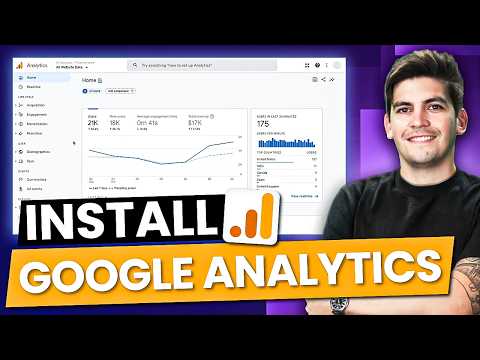How to Add Google Analytics to Your WordPress Site

If you’re venturing into the exciting world of website analytics, Google Analytics is your new best friend. This powerhouse tool offers insights into your site’s traffic and user dynamics, allowing you to make data-driven decisions.
Understanding your audience’s behavior can transform your website strategy, providing you with the tools to enhance user experience and grow your reach. Thankfully, adding Google Analytics to your WordPress site is a straightforward process that can unlock a treasure trove of data.
Imagine knowing which posts your visitors love most or which sources are driving the most traffic! Whether you’re just starting out or looking to optimize your strategy, integrating Google Analytics with WordPress is a step you can’t afford to skip.
Ready to unlock the secrets behind those visits and page clicks? Let’s dive into the simple steps to set up Google Analytics and start benefiting from all that juicy data.
Why is Google Analytics Important for Your WordPress Site?
In the digital realm, knowledge is power, and Google Analytics is your gateway to understanding your site’s performance. It arms you with critical insights into who your visitors are, where they come from, and what they do on your site. This knowledge helps you tailor your content and marketing strategies to better meet your audience’s needs.
With Google Analytics, you can track which posts capture the most attention and which ones might need a refresh. You’ll gain clarity on which keywords are driving traffic and which social media channels are sharing your content with a broader audience.
These insights go beyond mere vanity metrics. They inform choices that can enhance user experience, supporting SEO efforts and ultimately boosting conversions. By pinpointing bottlenecks in your sales funnel or discovering new opportunities to engage your visitors, you’re able to consistently refine your approach.
Incorporating Google Analytics into your strategy turns guesswork into informed strategy, putting you on the path to building a more successful site. Whether you’re blogging for passion or profit, understanding your analytics is crucial to crafting a winning formula for growth.

Step-by-Step Guide: Installing Google Analytics on WordPress
Getting Google Analytics set up on your WordPress site is easier than you might think. Let’s walk through the process together!
First, you’ll need a Google Analytics account. Head over to the Google Analytics website and sign in with your Google account. If you don’t have one, you’ll need to create one. Once signed in, click on “Start measuring” to set up your account.
After setting it up, you’ll be guided to create a property—a fancy term for your website. Fill in the details and grab your unique tracking ID. Keep this code handy; it’s your new best friend for the next steps.
Now, it’s time to head to the WordPress admin panel of your site. Go to your theme’s header.php file and paste the tracking code right before the closing </head> tag. Don’t forget to save your changes!
If tweaking code isn’t your thing, consider installing a plugin like MonsterInsights or Google Site Kit. These plugins make adding Google Analytics a breeze without diving into code, with simple instructions to guide you through the setup.
Voilà, you’ve added Google Analytics to your WordPress site! Data insights are just around the corner, ready to boost your strategy.
Understanding Google Analytics Metrics for Your Site
Once you’ve set up Google Analytics, it’s time to dive into the data. But what do all those numbers and graphs really mean?
Let’s start with sessions. A session is essentially a group of user interactions with your site within a given time frame. It helps you understand the volume of visits your site receives.
Next, users. These are the unique visitors to your site. Knowing how many individual users visit can help gauge your reach.
Pageviews tell you how often pages on your site are being viewed. More isn’t always better, though—pair this with average session duration to see if visitors are truly engaged.
Speaking of which, average session duration reveals how much time users spend on your site. Longer durations often indicate that your content is engaging.
Bounce rate is another key metric to watch. It shows the percentage of users who enter and leave your site without interacting further. A high bounce rate may indicate that you need to enhance your landing pages.
These metrics combined give you a comprehensive picture of how well your site is performing and where improvements can be made. With this knowledge, you’re already on your way to mastering Google Analytics!
Optimizing Your WordPress Site Using Google Analytics Data
Harnessing the power of Google Analytics data allows you to refine and elevate your WordPress site’s performance. Let’s explore how to convert insights into impactful actions.
Enhancing User Experience
Start by examining user flow to understand how visitors navigate your site. Are there pages where users drop off frequently? Look for patterns in the user journey that might indicate areas for improvement. Perhaps your calls-to-action need tweaking, or the content isn’t as engaging as it could be.
From there, dig into the performance of specific pages. High-traffic pages with low engagement might need a content refresh or improved visual elements. Ensuring high-quality content and intuitive design on these key pages can significantly boost user satisfaction.
Boosting Traffic and Engagement
Next, assess your acquisition data to uncover which channels bring the most traffic. Are organic searches your top driver, or does social media rule the roost? This information lets you focus your marketing efforts efficiently.
Additionally, keywords that frequently lead users to your site offer insights into what your audience is interested in. Tailoring your content strategy around these topics can enhance your visibility and encourage more visits.
With a data-driven approach, you’re not just managing your site; you’re creating an optimized user experience that keeps visitors coming back for more!
The Bottom Line: Utilizing Google Analytics for Your WordPress Site’s Success
Google Analytics is more than just a tool; it’s a bridge to understanding your website’s strengths and weaknesses. Integrating it into your WordPress site provides you with invaluable insights, guiding you in refining and optimizing your content strategy. By tapping into its rich data, you can clearly see how visitors interact with your site, shedding light on the kinds of content that resonate with your audience.
Armed with these insights, you can make informed decisions to improve user experience. Whether it’s streamlining navigation, enhancing load times, or crafting content that truly captivates, data-driven optimizations can lead to more engaged visitors and ultimately, a more successful site.
Coupled with this, understanding traffic sources allows you to fine-tune your marketing strategies. With a sharper focus on the channels driving the most engagement, you can better allocate efforts to maximize reach and impact. Similarly, evaluating keywords and search terms empowers you to tailor your SEO strategy effectively, keeping you competitive in your niche.
Google Analytics offers an unprecedented level of insight. Its powerful data can transform how you perceive your site’s performance, pushing you towards achieving your goals. In essence, embracing this potent tool equips you to build a thriving WordPress site that not only attracts but also retains your desired audience. In the ever-evolving landscape of the web, being data-savvy isn’t just an advantage; it’s a necessity. So, roll up your sleeves and let Google Analytics be your compass in navigating to success.



